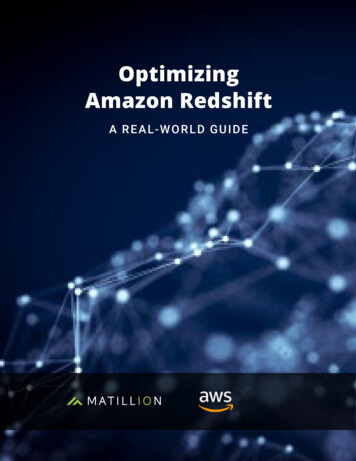
Transcription
OptimizingAmazon RedshiftA R E A L-W O R L D G U I D E
TA B L E O F C O N T E N T S3About this book4Chapter 1: Amazon Redshift Architecture12Chapter 2: Data Loading Optimizations16Chapter 3: Data Querying Optimizations21Chapter 4: Managing Costs on Amazon Redshift24Conclusion25About Matillion
About this bookChapter 1: Amazon Redshift Architecture. Look under the hood” to understand Amazon Redshift’stechnical workings. Gain insight into how Amazon Redshift Spectrum provides superior scalability whencompared to other cloud offerings.Chapter 2: Data Loading Optimizations. Learn best practices for how to efficiently load data intoAmazon Redshift to improve business performance and to save costs.Chapter 3: Data Querying Optimization. Make the most of Amazon Redshift’s power to query andtransform data.See how you can best scale your compute power to load and query large datasets byusing Amazon Redshift Spectrum.Chapter 4: Manaing Costs on Amazon Redshift. Save costs by leveraging Amazon Redshift’s pay-asyou-go pricing model, making Amazon Redshift more cost efficient than on-premise alternatives. Learnhow you can better forecast, limit, and control your costs.KeyWhen reading the eBook, look out for colored boxes for additional resources, how to’s, best practices,and hints and tips.Further details and resources‘How to’ information and examplesBest Practices and optimizationsHints and tips from Matillion3 INTRODUCTION
CHAPTER 1Amazon RedshiftArchitecture4 CH.1 A M A Z O N R E D S H I F T A R C H I T E C T U R E
CHAPTER 1Modern businesses possess and continually generate greater volumes of data than ever before. To gainvalue from this data, businesses are seeking methods to leverage it as a means to make better, moreinformed decisions. The challenge they face is how to get that data across its various locations andshapes into a cloud data warehouse and in an analytics ready form - not a trivial task.Many choose cloud data warehouses as a centralized repository to empower analytics-based decisionmaking from this variety of data - but you likely have already taken that step and are either evaluating orare currently making use of Amazon Redshift as your cloud data warehouse. Selecting Amazon Redshiftputs your business ahead of the curve (and your competitors, with their outdated on-premises databases)and gets you further down the path towards turning data-driven decision making into a normal, every dayevent for your business.Whether you’re a data warehouse developer, a data architect or manager, a business intelligencespecialist, an analytics professional, or a tech-savvy marketer, you now need to make the most of theAmazon Redshift’s platform to get the most out of your data. That’s where this eBook comes in handy. Itintroduces the Amazon Redshift warehouse and helps you understand the various options available formanaging your data and transforming your business’ data into decisions.This eBook is brought to you by Matillion. Matillion is an industry-leading data transformationsolution that was originally introduced on Amazon Web Services for the Amazon Redshift clouddata warehouse. Delivering a true end-to-end data transformation solution (not just data migrationor data preparation), Matillion provides an instant-on experience to get you up and running in justa few clicks, a pay-as-you-go billing model to cut out lengthy procurement processes, as well asan intuitive user interface to minimize technical pain and speed up time to results. Matillion’sdata transformation solution is available for Amazon Redshift on the AWS Marketplace.More information is available at www.matillion.com.What is Cloud Data Warehousing?Cloud Data Warehousing applies the principles of cloud-based economics, scalability, and performance tomodern data warehouse implementations. Given that today’s businesses generate staggering amountsof data, learning to get the most value from that data is paramount to success.Just as Amazon Web Services (AWS) transformed general IT infrastructure by delivering on-demand,scalable, fast, and cost-effective computing resources, Amazon Redshift does the same for datawarehousing and big data analytics.As a user, you can interact with BigQuery in a few ways: The Google BigQuery web console5 CH.1 A M A Z O N R E D S H I F T A R C H I T E C T U R E A client-side API, with bindings
Organizations choose Amazon Redshift for its affordability, flexibility, and powerful feature set: Massively Parallel Processing (MPP) columnar datastore spins up quickly and can process billions ofrows of data at the cost of just a few cents an hour Supports client connections with many types ofapplications, including business intelligence (BI),reporting, data, and analytics tools Enterprise-class relational database query andmanagement system Execute analytic queries to retrieve, compare, andevaluate large amounts of data in multiple-stageoperationsAmazon RedshiftAmazon Redshift is designed for performance and ease of use, reducing development time and savingmoney on data storage and compute for your business.1.1 How is Amazon Redshift different?Businesses have been using proprietary, on-premises, RDBMS platforms as Data Warehouse back-endsfor decades. Even when clustered, such platforms fail to deliver cost effectiveness, flexibility, scalability,and performance compared to Amazon Redshift.Traditional RDBMS (Oracle, SQL Server) and MPP (Netezza, Teradata, Vertica) platforms represent a largecapital expenditure for your data warehousing organization, particularly when proprietary license feesare required. These licenses vary from expensive to extraordinarily expensive, with open source platformsalso requiring the purchase of costly hardware. Owning hardware requires high-priced configuration andmaintenance, and often hardware must be purchased ahead of the demand for it. This means you’repaying for excess capacity that is ultimately limited and won’t be able to grow without further investment.If you are migrating from an on-premise databases, such as MySQL, Oracle, DB2, PostgreSQL, Teredata or any otherJDBC compliant RDMS, to Amazon Redshift, Matillion has an easy to configure Database Query Component, gettingyour business data to the cloud with speed and simplicity.Amazon Redshift, on the other hand, offers a pay-as-you-go model which allows you to smoothly scaleyour capacity and costs in line with your organization’s demand for data warehousing capabilities.1Amazon Redshift compute nodes can be sized up or added with a few clicks - without the burden ofexpensive licenses. Plus, Amazon Redshift is primarily a managed solution allowing you to focus on thedata and developing your warehouse rather than maintaining it. On top of that, Amazon Redshift scalesalmost limitlessly with the ability to grow, process, and query datasets up to petabyte scales.1 Amazon also offers a Reserved Node payment model, which offers a large discount in exchange for a 1- or 3-year commitment. See the section below on Using Reserved Nodes.6 CH.1 A M A Z O N R E D S H I F T A R C H I T E C T U R E
1.2 Under the Hood of Amazon RedshiftAmazon Redshift instances are delivered as a cluster, containing both a leader node as well as anumber of compute nodes. You decide at the cluster level whether to optimize your Amazon Redshiftimplementation for computing power or high storage capacity. Specifying dense storage nodes createsa cluster optimized for huge data volumes with hard disk drives (HDDs), while the dense compute optionuses solid state disks (SSDs) for faster performance. Clusters can be resized at any time as long as thecluster itself remains large enough to house the amount of data it already contains. In the past, clusterresizes needed to be planned carefully as they caused the database to go into “read only” mode duringthe resize operation; manual cluster resizes still incur such outages. Recently, however, Amazon addedElastic Resize, which minimizes downtime.Please see Resizing Clusters documentation from Amazon for more details.As noted above, each Amazon Redshift cluster is made up of a leader node and at least one computenode. The leader node serves as the point of communication for your application, which presents itself assingle, cohesive data warehouse even though, behind the scenes, the leader node is actually coordinatingactivity across as many as 128 compute nodes. From the outside, the leader node looks like a Postgresdatabase, on which Amazon Redshift’s core technology was originally based.The actual work the user requests of the cluster is done by the its compute nodes, each one a virtualmachine. Each node contains multiple slices, which are roughly analogous to a processor or core allocatedto work on the data contained within that particular node. The leader node allocates work to the computenode, which further distributes the work among its available slices. The correct use of slices allows thecluster make use of its massive parallel processing (MPP) capabilities. When the cluster allocates workto a node, the node can further divide this work down across its available slices as long as the data isdistributed appropriately.More on this in our Massively Parallel Processing section below.The more nodes you have, the more work your Amazon Redshift cluster is capable of. However, in theabsence of best practices, additional nodes can yield negligible (or in fact negative) real world performanceand scalability gains. It’s also worth bearing in mind that the more nodes your Amazon Redshift clusterhas, the more expensive it is to run.Optimum performance depends on following best practices for schema design to ensure the right datais distributed to the right nodes. Let’s consider some of Amazon Redshift’s more advanced features andthen review Amazon Redshift optimization and best practices.7 CH.1 A M A Z O N R E D S H I F T A R C H I T E C T U R E
1.3 Advanced FeaturesCOLUMN ORIENTATIONTraditional RDBMS platforms are row oriented: their queries must fetch entire records from disk. In manycases, this approach incurs large amounts of unnecessary work, especially when the end user is onlyinterested in a small subset of columns from the tables in question.If you were implementing a data warehouse on one of these traditional RDBMS platforms you wouldlikely design a star-schema, populate it with data, and then index the fields that users want to filter andgroup by. But because knowing all the queries your user base will ask in advance is very difficult, you endup indexing everything. At which point, you have got two complete copies of your data: one in the maintables, and one in the indices.Columnar data stores, like Amazon Redshift, solve this problem by conceding that every column of interestis going to need an index. It thereby does away with the main data store. In this way, Amazon Redshift’sarchitecture combats unnecessary, row-level work by organizing itself with a column orientation, and onlyperforming input and output (I/O) operations for the columns required by a given query. Additionally, andbecause you can’t know in advance what fields your users want to filter on, columnar data stores createa data structure similar to an index for every column of data, thus eliminating the tabular data store.As such, each column only exists in Amazon Redshift as an indexed structure. All values of the same typeand those with similar values are organized next to each other in the indices, which makes compressionfar more efficient than in traditional relational database management systems.Terrific compression, since values in a single column are likely to have similar values which compressioncan take advantage of.Columnsnotincludedin a query are never read from disk,whichcan improveperformance. A cessuch as JDBC and ODBCfor icalcan Java,be eys and indexes to Third-party tools such as izequeryperformance.Node.js, PHP and Ruby A command line interface (which itself uses the Python API)In most database platforms, “column encoding” refers to the character set used in the column (e.g.Latin-1 or Unicode). Not so with Amazon Redshift, which always stores data using UTF-8 and Unicode.Here, “column encoding” refers instead to the different compression strategies you can use for the datadistributed within each column. You can allow Amazon Redshift to choose one for you, or you can selectone manually based on your storage and performance preferences. Compression preserves your I/Ochannels’ capabilities and increases throughput.8 CH.1 A M A Z O N R E D S H I F T A R C H I T E C T U R E
MASSIVELY PARALLEL PROCESSING (MPP)Amazon Redshift is an MPP platform. Designing your tables to take advantage of this parallelism is criticalto good performance across large datasets, which leverages Amazon Redshift’s various distribution styles.The discussion below highlights the performance benefits of these different styles.ALL DistributionALL is the simplest distribution style. Setting a table to use this distribution style instructsAmazon Redshift to make a complete copy of the table on every node in the cluster. The benefit here isthat when you ask the cluster to execute a query that includes a join, each node executing that join has alocal copy of the table. As such, Amazon Redshift isn’t required to copy the data across the network fromnode to node to complete the query. Otherwise, if a particular node is tasked with completing part of ajoined query but didn’t have the required data locally, it would have to reach into other nodes in the cluster,negatively affecting query performance by incurring additional network chatter. The downside of usingthe ALL distribution style is that the table is duplicated on every node, which takes up additional space.This distribution style is, therefore, best suited to small reference or dimension tables that are frequentlyjoined to larger, fact tables.Simple distribution style that doesn’t requiring copying the data, which improves performance.This might not be ideal for large tables since ALL distribution duplicates tables on every node, usingadditional space.EVEN DistributionSpecifying EVEN distribution balances table rows on each node in the cluster. Queries involving thattable are then distributed over the cluster with each slice on each node working to provide the answerin parallel. This distribution style is an especially optimal choice when tables aren’t involved in joins.Conversely, joins involving rows matched by tables on different nodes increases network traffic anddiminishes query performance. The exception is when joining from tables using EVEN to tables using anALL distribution style since the second table’s records are already available on each node in the cluster.Use EVEN distribution when you are not using joins.Automatic DistrubtionAbsent another distribution style specification, Amazon Redshift will use an automatic distribution.Tables start out with an ALL distribution style and then are switched to EVEN distribution as thetable’s volume grows.N OTE: U S ING A UTOMA TIC DISTR I B U T I O NNote that when Automatic Distribution changes from ALL to EVEN, is one directional; Amazon Redshift will never reverse the distributionstyle from EVEN back to ALL for tables with low volumes.9 CH.1 A M A Z O N R E D S H I F T A R C H I T E C T U R E
KEY DistributionWith a KEY distribution style, you specify a column to distribute on and then, cleverly, Amazon Redshiftensures that all the rows with the same value of that key are placed on the same node. An exempleuse case of a KEY distribution would be to optimize a join between two large tables, each using thesame column or columns for its distribution key. Here, you don’t want to set either table to ALL, becauseduplicated storage would be too expensive. EVEN distribution, throughout the course of the join, wouldlikely force each table segment to interact with every segment in the other table, creating large amounts ofnetwork congestion and poor performance. Instead, distributing both tables on their common key or keysand then joining on those fields will perform well, because the common keys in both tables are guaranteedto be co-located on the same nodes.Using KEY distribution ensures that common keys are handled by the same node, which is ideal for joininglarge tables as it will cost less than other distribution options.1.4 Amazon SpectrumHistorically, when a data warehouse reached capacity, users would have to go through a time-consumingapproval, procurement, and implementation process before a they could finally add and utilize improvedwarehouse capacities. Then, users would spend the next year or so consuming the capacity they added,only to run out again at a later time.Amazon Redshift offers a huge improvement over this process, allowing a cluster to be resized with afew clicks, or even scaled automatically. Still, manual resize operations (now known as “classic resizes”)terminate all executing queries both when the resize command is issued and then again after it completes.The Amazon Redshift cluster also remains in read-only mode during classic resizes when the operation isdone. Elastic resizes offer improvements here, but some downtime is still required in elastic mode.For more information on resizing check out AWS’ documentation on Elastic Resize.Amazon Spectrum allows users to write SQL against very large datasets stored in Amazon Simple StorageService (S3), without having to load them into Amazon Redshift. Amazon Spectrum utilizes thousands ofnodes in order to scale independently and run rapid queries on ‘External’ tables. It also allows for tablesto be seamlessly joined across Amazon Redshift and Amazon S3.With Amazon Spectrum, data volumes can keep growing on Amazon S3 without interrupting dataprocessing to scale up capacity since it scales independently and without any downtime. With this service,users can now scale to accommodate larger and larger amounts of data than the Amazon Redshift clusterwould have otherwise been capable of processing with its own resources.10 CH.1 A M A Z O N R E D S H I F T A R C H I T E C T U R E
2NO TE: U S ING A MA ZON A TH E NA A N D S P E CT R U MAmazon Spectrum also shares a catalogue with Amazon Athena and Amazon Glue, so they can be used together. This is useful if youare pursuing a Data Lake strategy in Amazon S3 as it makes the same datasets available to the other Amazon services you are using.11 CH.1 A M A Z O N R E D S H I F T A R C H I T E C T U R E
CHAPTER 2Data LoadingOptimizations12 CH.2 D ATA LO A D I N G O P T I M I Z AT I O N S
CHAPTER 2Turning now back to Amazon Redshift (as opposed to Amazon Spectrum), let’s consider how to get themost out of AWS’ warehousing platform.Designing for PerformanceFollowing the best practices below as you create a schema saves you from 1) time-consuming schemareorganizations as well as 2) having to compose complicated queries later to get the answers you need.Amazon Redshift makes it simple to start gaining actionable insights from your data. Here are sometechniques we’ve identified that can help streamline the load and query processes, saving you time andleveraging your resources in the most effective way. Once your Amazon Redshift schema contains data,changing it will be time-consuming.2.1 Best PracticesDATA LOADING OPTIMIZATIONThere are several ways to use Amazon Redshift to move data. Based on our experience, we’ve created alist of best practices to help make your usage as productive and smooth as possible.COPY CommandUse the COPY command to load data into Amazon Redshift. The first time you use the command topopulate an empty table, use a significant and representative dataset so Amazon Redshift can evaluate itproperly and optimize compression for your particular data distribution.A single COPY command can be used to load multiple files simultaneously. The COPY command treatsmultiple files as one, large logical file, so the load will happen in parallel and at much higher speeds.Ideally, the number of files should map to a multiple of the number of slices in the Amazon Redshiftcluster - each slice loads a single file. As such, the files should be of roughly equal size so the work isdistributed approximately evenly.Avoiding both multi-row and single inserts in favor of preparing an input file on Amazon S3. Nothing beatsthe COPY command for performance!Numerous examples of how toAmazon Redshift COPY Examples.13 CH.2 D ATA LO A D I N G O P T I M I Z AT I O N SemploytheCOPYcommandareavailable here:
Table Distribution and Sort KeysDefine table distribution styles prior to loading in anticipation of their access paths.Use the ALL distribution style for smaller dimension and reference tables Use EVEN for large, staging tables that are either Use the KEY distribution style to distribute rows1) not joined to other tables or 2) are only joined toaccording to the values in a given column. Thistables having an ALL distribution style.places matching values on the same node slice andfacilitates joins between tables distributed on the Use the automatic distribution style (by specifyingsame key.no distribution style at all), which will start tables offusing the ALL distribution style and switch them toEVEN as they grow.Specifying the same column as both the sort and distribution key allows Amazon Redshift’s optimizer touse a sort merge join, which is faster than a hash join operation.As with distribution keys, it’s best to specify sort keys prior to data loads by anticipating typical accesspaths for the table in question. Choose the best sort key, optimizing first for joins and then for filtering.Use Spectrum to help with filtering and aggregating very large data sets. Filter and aggregate withAmazon Redshift Spectrum to take the load off the data warehouse. Then you can start joining data, whichcan be handled within Amazon Redshift.CompressionCompress data files prior to (or during) your load operation. The CPU time spent is regained in reducedbandwidth requirements and faster data transfer times.H ELP FUL HI NT: COMPRE SSION O N S P E CT R U MCompressing your files before they’re loaded into S3 decreases Amazon Spectrum query times and consequently reduces costsfor both storage and query execution. Although AWS supports several compression schemes, certain compression types and fileformats enhance performance more than others.We recommend Parquet, which is both column-oriented and compressed. In testing, these filesprocessed twice as fast as CSV and compressed CSV files. However, converting existing data files tothe Parquet format can be time-consuming; doing so is only worthwhile if the data fits squarely into awrite-once-read-often access pattern.14 CH.2 D ATA LO A D I N G O P T I M I Z AT I O N S
Bulk Loading DataUse bulk insert operations to create copies of data already inside your Amazon Redshift cluster. Theseoperations work quickly and can leverage Amazon Redshift’s built-in functions to transform data into adifferent format on the fly. Bulk insert operations include inserting SELECT statements into existing tablesas well as the CTAS (Create Table As Select) statement.Efficiently move data from staging tables into persistent table structure.Manipulate data using SQL functions built natively into Amazon Redshift.Relies on user to clean up staging data after bulk load completes.Organizing your DataOrganizing your data at load time means you can access this data more efficiently at a later time. Forexample, time series data with a limited retention period should be loaded into separate tables accordingto the periodicity you desire. Such tables should have the same table structure and only be differentiatedby the time element specified within the table name. Doing so allows you to drop whole tables to prunethe oldest data, which avoids the need to execute VACUUM commands after deletes.Use date/time data types to store date values rather than storing string-based versions of the same.Doing so allows you to use Amazon Redshift’s rich set of date functions.Matillion ETL for Amazon Redshift has over 60 pre-built data connectors. Check our all our integrations here.Don’t see what you need? We have a universal API connector and JDBC driver for enabled data sources.15 CH.2 D ATA LO A D I N G O P T I M I Z AT I O N S
CHAPTER 3Data QueryingOptimizations16 CH.3 D ATA Q U E RY I N G O P T I M I Z AT I O N S
CHAPTER 3Designing for EfficiencyIn addition to loading optimizations, there are some steps you can take to improve performance andreduce costs when querying your data.3.1 Best PracticesDATA QUERYING OPTIMIZATIONTo start fully benefiting from the power of Amazon Redshift, you’ll want to start querying and transformingyour data. Here are some best practices for querying data in a way that is efficient for Amazon Redshift,saving you critical resource.VacuumAmazon Redshift recently added an auto-vacuum feature that removes fragmentation caused by deleteoperations. This automated VACUUM DELETE ONLY job runs at times when system use is low and pausesitself if user activity picks up while the job is running. However, this job only reclaims disk space for deletesand does not address any sort key maintenance needed as a result of updates. If you frequently updatesort key columns we suggest scheduling VACUUM SORT ONLY operations during off hours to avoid usersexperiencing performance degradation due to resource scarcity.Restores any sort key efficiency lost due to fragmentationTime consuming operation best executed during off hours.Workload Management CapabilitiesConfigure Workload Management (WLM) to ensure higher-priority queries always have access to theresources they need to complete in a timely manner. We suggest configuring separate queues forreporting, data transformation processes, superusers, and any other high-priority operations you run onAmazon Redshift. This ensures that no one class of users will overwhelm the cluster with queries thatprevent others from getting their work done.Prioritize your queries and manage your workloads, to ensure you have the resources needed, when youneed them.17 CH.3 D ATA Q U E RY I N G O P T I M I Z AT I O N S
ANALYZE CommandsMaintain up-to-date table statistics by running ANALYZE commands automatically on load, especiallyduring the COPY processes. Doing so gives Amazon Redshift’s query optimizer the statistics it needs todetermine how to run queries with the most efficiency.If, you are making use of Amazon Redshift Spectrum features, there is no equivalent ANALYZE commandto use. However, you can specify a numRows property on Spectrum objects and setting these valuesaccurately helps the optimizer do a better job when developing execution plans.Use Analyze commands to make sure Amazon Redshift can build the most optimal query execution plans.Spectrum tables don’t have an ANALYZE equivalent. Instead, the numRows property can be used.Like VACUUM, ANALYZE commands can consume significant resources; be sure to run them when userswon’t be affected or use WLM settings to minimise their impact.Review Execution PlansUse the EXPLAIN command to review query execution plans. Note that MERGE joins are the best andmost performant join type in Amazon Redshift (unlike traditional RDBMS systems). Wherever possible,eliminate the HASH joins in your execution plans in favor of MERGE joins by joining on columns that areincluded in both tables sort and distribution keys.EXPLAIN commands allow you to review your execution to identify and address performance bottlenecks.Avoid HASH joins as these will be less performant and may make queries cost more. Instead use MERGEcommands to reduce costs and improve performance.Scale UpIt may be that your query is running optimally and simply doesn’t have the resources it needs to providean adequate response time. The beauty of cloud-base data warehouses is the ability to scale them up tobring more computing power to bear. Consider scaling your cluster up to leverage a more powerful cluster against your response time requirements. As volumes grow, you can scale to adapt to more and moredata, which lets you leverage pay-as-you-go cloud economics.Scale your cluster to ensure you have the resources to handle growing data volumes.Scaling up will costs more, so make sure you’re adding capacity that’s needed.18 CH.3 D ATA Q U E RY I N G O P T I M I Z AT I O N S
Partitioning DataIf you are using Amazon Redshift Spectrum, we advise partitioning your data. Partitioning allows you touse one table definition with multiple files, each a subpart of that same table. This can increase your queryefficiency and potentially reduce the cost of executing your queries. You can partition tables so that youhave different data files in different places on Amazon S3, which can then be queried as if they were a onelarge table. Date partitions can also be used to quickly and easily prune data to filter out unneeded records and focus on a specific subset. This is especially useful for time series data with which we suggestcreating a table that defines the partition according to some time element, i.e. year, month, or day. Thisreduces costs by allowing Spectrum to process only partitions that are relevant to the query. Check yourexecution plans to confirm that the partition filter is taking place in Spectrum.Follow Amazon’s best practice for partitioning data: Use columns that you commonly filter by as partitions. Conduct partition pruning. Consider “file placement, query pattern, file size distribution, number of files in a partition, number ofqualfied partitions” which also affect performance.Amazon Redshift’s flexibility, and native ability to interact with standard SQL and your exist
What is Cloud Data Warehousing? Cloud Data Warehousing applies the principles of cloud-based economics, scalability, and performance to modern data warehouse implementations. Given that today's businesses generate staggering amounts . Massively Parallel Processing (MPP) columnar data store spins up quickly and can process billions of
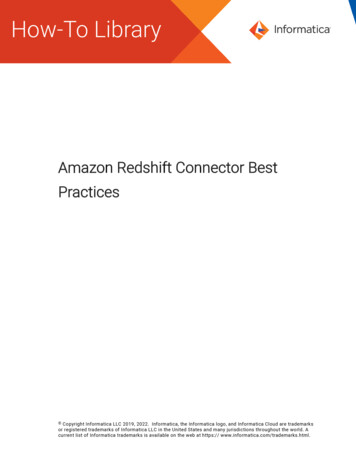
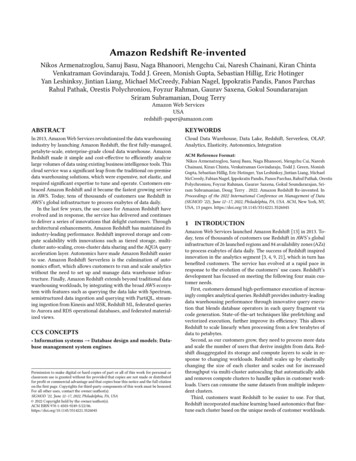
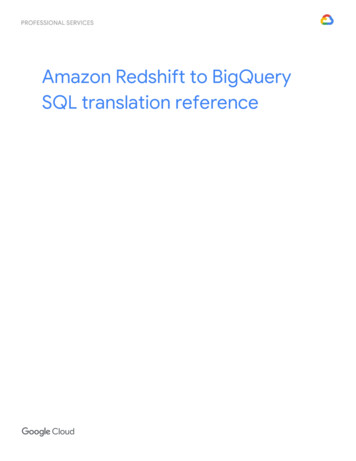
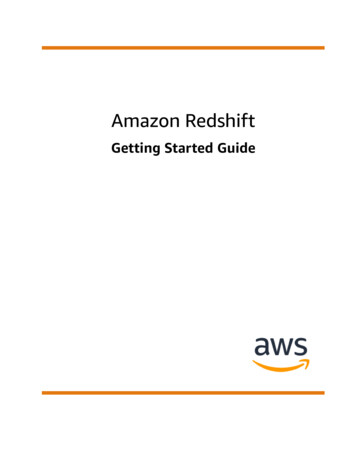
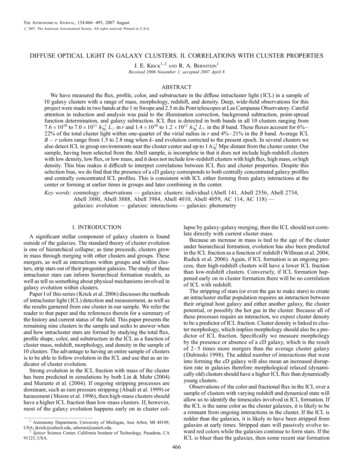
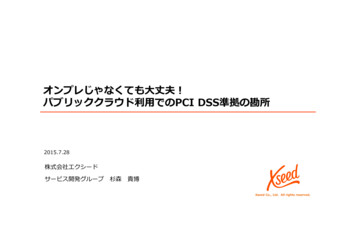

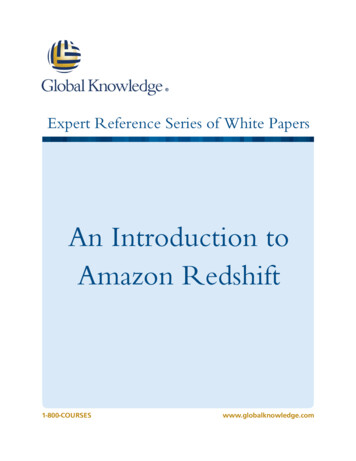
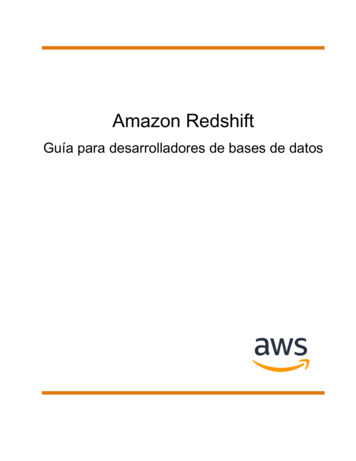
![Index [beckassets.blob.core.windows ]](/img/66/30639857-1119689333-14.jpg)
